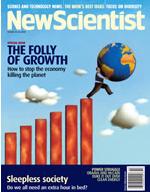New Scientist points out a few home truths this week in its special issue “The Folly of Growth”. Basically, the economic development the world is experiencing is unsustainable, something that’s worth keeping in mind as electioneering politicians use OECD growth statistics to make a point about our economic progress or lack thereof compared to other OECD countries.
 Growth – particularly in GDP, is likely to become less of a fashionable measure of a country’s progress if the world gets serious about tackling climate change. That’s due to the inconvenient truth illustrated by the Ehrlick equation I=PAT, dreamt up by ecologist Paul Ehrlick 40 years ago.
Growth – particularly in GDP, is likely to become less of a fashionable measure of a country’s progress if the world gets serious about tackling climate change. That’s due to the inconvenient truth illustrated by the Ehrlick equation I=PAT, dreamt up by ecologist Paul Ehrlick 40 years ago.
In I=PAT, the I stands for the impact of human activity on the planet, P is the size of the population, A is the level of affluence expressed as income per person and T is the impact on the planet associated with each dollar we spend.
Now look at the figures Tim Jackson, professor of sustainable development at the University of Surrey, applies in his New Scientist column:
“The global population is just under 7 billion (P) and the average level of affluence (A) is around US$8000 per person. The T factor is just over 0.5 tonnes of carbon dioxide per thousand dollars of GDP – in other words, every $1000 worth of goods and services produced using today’s technology releases 0.5 tonnes of CO2 into the atmosphere.”
So today’s global CO2 emissions work out at:
7 billion x 8 x 0.5 = 28 billion tonnes per year.
Unfortunately, the Intergovernmental Panel on Climate Change research suggests that to stabilise greenhouse gas emissions we need to cut annual CO2 emissions to less than 5 billion tonnes by 2050. That’s despite the world’s population expected to reach 9 billion by 2050.
Looking at those figures remind me of the visits I used to make to TV screen and computer factories in China and Japan as a technology reporter. The plasma screens would roll off football-sized production lines in the thousands every day. I’d shake my head in awe as we were given the guided tour, but a voice inside my head was saying: “yeah, everyone deserves to have a decent TV, but this isn’t sustainable”.
It gets worse because those figures, as Professor Jackson points out, don’t account for economic growth. If the western countries continue to grow at 2 – 3 per cent a year, Indian and China rocket ahead at 5 – 10 per cent a year we have a bit of a problem:
“…to meet the IPCC target we would have to push the carbon content of consumption down to less than 0.03 tonnes for every thousand US dollars spent – a daunting 11-fold reduction on the current western European average.”
So where will the efficiencies come from? Clean technology and more efficient energy use will account for some of them, but in a forty year timeframe it’s unlikely we will come up with the technology to cancel out the impact on the planet of the increases in growth.
Which is exactly what is leading to the “visceral fear” Jackson sees as underpinning free market capitalism. We need more and more people to be able to afford the TVs rolling off that production line in Osaka, otherwise the whole system falls over. Since the beginning of humankind growth has generally been good. Now it threatens to undo us all.